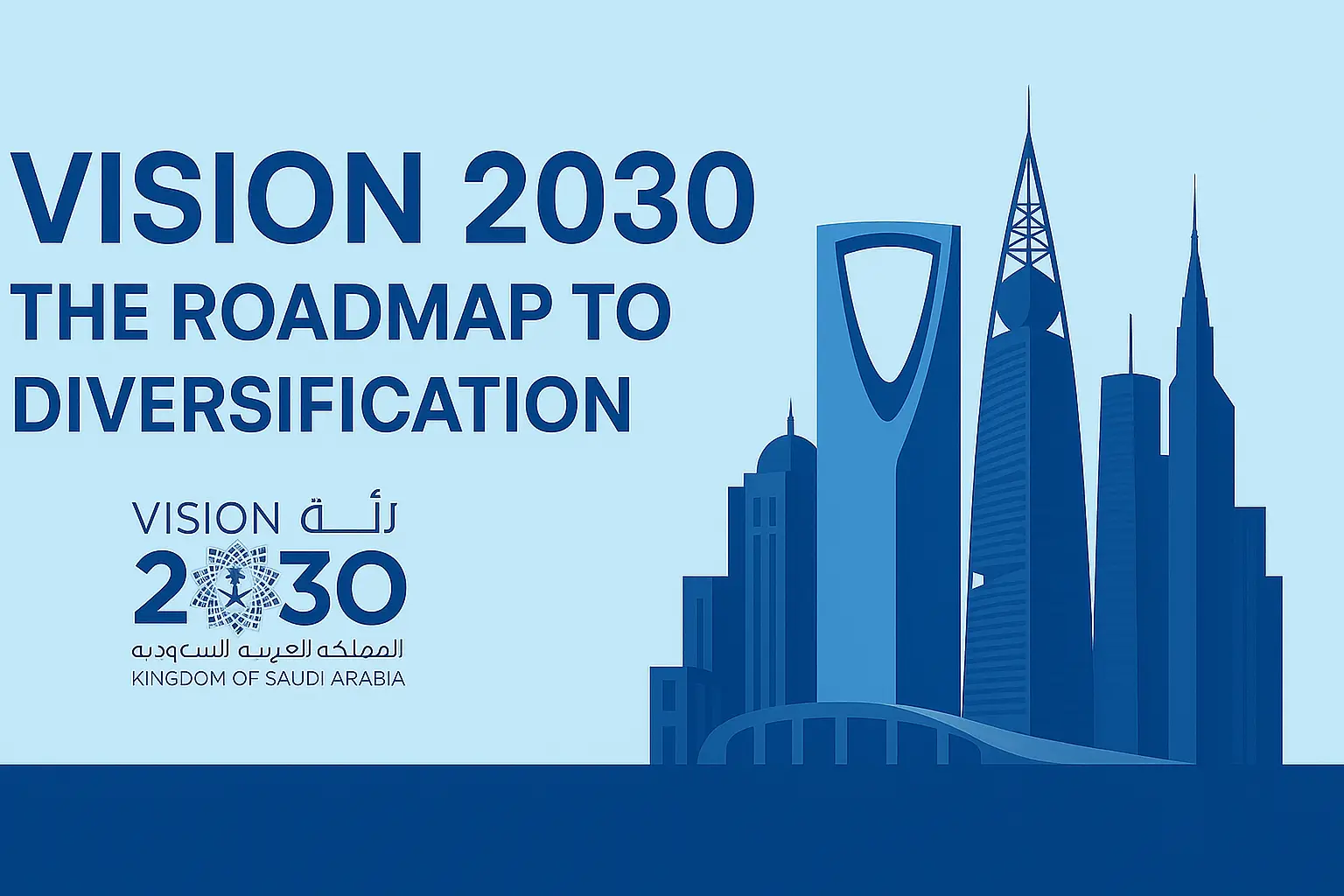Vision 2030 and Digital Transformation: Saudi Arabia’s Roadmap to a Sustainable Future
The Oil Price Shock and the Urgency for Economic Diversification
Discover how Saudi Arabia’s Vision 2030 is driving digital transformation across government, economy, and society. Explore key programs, smart city initiatives, AI adoption, and business innovations shaping the Kingdom’s post-oil future.
From June 2014 to January 2015, global oil prices plunged by nearly 60%, marking the steepest decline since 2009. This drastic fall was largely due to a surge in shale oil production in the United States, disrupting the global oil market and creating an oversupply. For oil-dependent economies like Saudi Arabia, which generates over 75% of its national revenue from oil, the shock exposed vulnerabilities in economic reliance on a single commodity.
The crisis accelerated the Kingdom’s need to diversify its economy and reduce dependence on oil revenues. This realization laid the foundation for Vision 2030, an ambitious blueprint to transform Saudi Arabia’s economy, society, and governance, ensuring sustainability in a post-oil world.
What is Vision 2030?
Launched in April 2016 under the leadership of Crown Prince Mohammed bin Salman, Vision 2030 is Saudi Arabia’s strategic plan to diversify its economy and modernize its society. The vision targets growth in non-oil sectors, including renewable energy, mining, manufacturing, logistics, tourism, retail, and entertainment.
Vision 2030 is divided into three phases:
- 2016–2020: Establishment of economic zones, smart city projects, and initiatives to improve the business climate and attract investment.
- 2021–2024: Accelerated digital transformation, including government and business digitization guided by the Digital Government Strategy, focusing on AI, cloud computing, and smart services.
- 2025–2030: Expansion and sustainability of reforms, increased partnerships, and cementing Saudi Arabia as a global leader in diversification and digitalization.
The Three Pillars of Vision 2030
Vision 2030 is structured around three core pillars aimed at comprehensive national development:
1. A Vibrant Society
Saudi Arabia aims to cultivate a society that embraces its cultural heritage while providing fulfilling lives for its people. Key goals include:
- Increasing average life expectancy to 80 years.
- Boosting household spending on local cultural and entertainment activities to 6%.
- Ranking three Saudi cities among the world’s top 100 cities.
- Doubling Saudi properties listed as UNESCO World Heritage Sites.
Programs under this pillar focus on enhancing education, healthcare, and social well-being.
2. A Thriving Economy
Economic diversification is vital for reducing oil dependency. The plan aims to:
- Increase the contribution of non-oil sectors to GDP.
- Elevate Saudi Arabia’s Logistics Performance Index to 25th place and Global Competitiveness Index to the top 10.
- Grow the Public Investment Fund assets to USD 1.86 trillion.
- Increase women’s workforce participation to 30% and reduce unemployment to 7%.
This includes developing digital infrastructure, supporting SMEs, deregulating markets, and expanding economic zones.
3. An Ambitious Nation
Saudi Arabia is committed to transparency, good governance, and accountability. Targets include:
- Increasing the GDP contribution from the nonprofit sector to 5%.
- Improving Saudi Arabia’s e-Government rankings and government efficiency.
- Raising non-oil government revenues to USD 265 billion.
This pillar encourages active participation across all sectors, fostering ethical and compliant practices.
How Vision 2030 is Driving Transformation
Innovating Financial Systems
Vision 2030 modernizes financial markets by integrating FinTech, facilitating funding for health, education, and transportation projects. The Public Investment Fund supports giga-projects like NEOM, Qiddiya, and Red Sea Global, driving economic diversification.
Elevating Living Conditions
With rising non-oil revenues, Vision 2030 improves the quality of life by expanding affordable housing through initiatives like the Sakani project, which aims for a 70% homeownership rate. The Human Capability Program enhances education and lifelong learning accessibility for all age groups.
Building a Diverse Economy
Tourism sees upgrades through digitalizing pilgrim services with e-visas and tour tickets, improving experiences for Hajj and Umrah visitors. The National Industrial Development and Logistics Program pushes growth in the energy, mining, manufacturing, and logistics sectors.
Modernizing Society with Digital Transformation
The National Transformation Program fosters a tech-savvy population and digital ecosystem to support both public and private sectors. Initiatives include deploying IoT, AI, cloud computing, and open-source solutions, advancing smart city projects like Waad Ashamal and SPARK.
Key Digital Transformations under Vision 2030
- Internet of Things (IoT) and Smart Cities: Saudi Arabia’s IoT market is projected to reach $2.9 billion by 2025, enabling enhanced connectivity for smart urban projects and businesses.
- Artificial Intelligence: Ranked first among Arab countries in government AI strategy, Saudi Arabia plans $1.9 billion AI spending by 2027, contributing $135 billion to GDP by 2030. Applications span logistics, transportation, and asset tracking.
- Cloud Computing: The first regional cloud computing special zone opened in 2023, attracting local and international businesses and supporting sectors like healthcare with scalable and compliant cloud solutions.
The Digital Government Strategy FrameworkSaudi Arabia’s
Digital Government Authority leads efforts to digitize governance, aligned with Vision 2030 and UN Sustainable Development Goals. Key goals include:
- Delivering comprehensive digital services accessible at every life stage.
- Creating a digital-first business ecosystem to streamline entrepreneurship.
- Using data analytics to enhance government efficiency and decision-making.
- Expanding private sector participation and attracting foreign investments.
- Implementing secure digital IDs for safe e-government access.
- Overseeing cloud adoption and cybersecurity across government agencies.
The Importance and Benefits of Digitalization
Digitalization in Saudi Arabia delivers:
- Streamlined public services are accessible online, with over 97% of government services digitized.
- Data-driven policymaking enables responsive and evidence-based governance.
- Enhanced data privacy frameworks ensure secure handling of sensitive information.
- Workforce upskilling with programs fostering digital literacy to meet modern labor market demands.
- Improved inter-agency coordination facilitates faster and more adaptive government responses.
SEMANTIC BRAINS: Empowering Digital Transformation in Business Governance
Saudi companies are embracing digital strategies to unlock growth in the Vision 2030 era. Board management is an early area benefiting from digital tools.
Semantic Brains is a leading board portal platform offering:
- Enterprise Cloud Hosting via STC Cloud for secure data exchange.
- Ease of Use across devices with minimal learning curves.
- Integrated Digital Signatures compliant with Saudi legal standards.
- Centralized Document Repositories improving file accessibility.
- Streamlined Meeting Management with scheduling, agendas, and real-time minute taking.
- Enhanced Collaboration through live annotations, voting, and synchronized views.
Over 100 Saudi organizations rely on Convene for secure, efficient, and paperless board operations—driving better governance in the digital age.
Conclusion
Saudi Arabia’s Vision 2030 is a bold and comprehensive blueprint for national transformation. By combining economic diversification with digital innovation, it aims to build a vibrant society, a thriving economy, and an ambitious nation ready for the future.
Digital transformation, from smart cities to AI adoption and cloud computing, plays a critical role in realizing these goals. Platforms like Convene are vital enablers, helping businesses and government sectors operate smarter and more effectively.
Together, these initiatives position Saudi Arabia as a global leader in sustainable development, digital governance, and economic resilience, laying the foundation for a prosperous post-oil future.
Read article
AI for a Sustainable Future: Saudi Arabia’s Green Vision
FAQs about Vision 2030 and Digital Transformation in Saudi Arabia
Q1: What is Saudi Arabia’s Vision 2030?
A1: Vision 2030 is Saudi Arabia’s strategic plan to diversify its economy, reduce dependence on oil, and modernize its society by 2030. It focuses on economic diversification, social development, and sustainable governance.
Q2: How is digital transformation integrated into Vision 2030?
A2: Digital transformation is a key pillar of Vision 2030, encompassing initiatives like smart city development, AI adoption, cloud computing, IoT expansion, and digitizing government services to improve efficiency and quality of life.
Q3: What are the three main pillars of Vision 2030?
A3: The pillars are:
- A Vibrant Society,
- A Thriving Economy,
- An Ambitious Nation focused on transparency, governance, and innovation.
Q4: How do smart cities fit into Saudi Arabia’s Vision 2030?
A4: Smart cities are integral to Vision 2030’s goal of building sustainable, connected, and technologically advanced urban centers that optimize resources, reduce environmental impact, and improve residents’ quality of life.
Q5: What role does AI play in Saudi Arabia’s digital transformation?
A5: AI supports automation, data analytics, predictive maintenance, personalized public services, and enhances sectors like logistics, healthcare, and education, making Saudi Arabia a regional AI leader.
Q6: How is Saudi Arabia ensuring data privacy during digital transformation?
A6: The Kingdom has implemented strict data governance frameworks and cybersecurity measures to protect citizen data and ensure ethical use of digital technologies.
Q7: What are some flagship projects under Vision 2030 related to digital transformation?
A7: Projects include NEOM smart city, The Line, Red Sea Development, and digital government initiatives enhancing e-services and cloud infrastructure.
Q8: How does Vision 2030 aim to improve the workforce through digital transformation?
A8: Through upskilling programs, digital literacy initiatives, and promoting STEM education to prepare citizens for the demands of a technology-driven economy.


